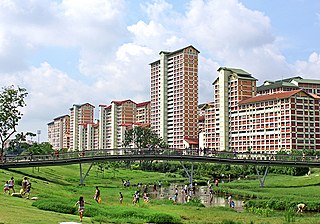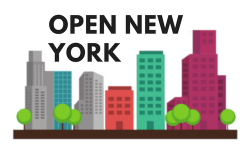Related Research Articles

Public housing is a form of housing tenure in which the property is usually owned by a government authority, either central or local. Although the common goal of public housing is to provide affordable housing, the details, terminology, definitions of poverty, and other criteria for allocation vary within different contexts.

Urban renewal is a program of land redevelopment often used to address urban decay in cities. Urban renewal involves the clearing out of blighted areas in inner cities to clear out slums and create opportunities for higher class housing, businesses, and other developments.
Supportive housing is a combination of housing and services intended as a cost-effective way to help people live more stable, productive lives, and is an active "community services and funding" stream across the United States. It was developed by different professional academics and US governmental departments that supported housing. Supportive housing is widely believed to work well for those who face the most complex challenges—individuals and families confronted with homelessness and who also have very low incomes and/or serious, persistent issues that may include substance use disorders, mental health, HIV/AIDS, chronic illness, diverse disabilities or other serious challenges to stable housing.

The New York City Housing Authority (NYCHA) is a public development corporation which provides public housing in New York City, and is the largest public housing authority in North America. Created in 1934 as the first agency of its kind in the United States, it aims to provide decent, affordable housing for low- and moderate-income New Yorkers throughout the five boroughs of New York City. NYCHA also administers a citywide Section 8 Leased Housing Program in rental apartments. NYCHA developments include single and double family houses, apartment units, singular floors, and shared small building units, and commonly have large income disparities with their respective surrounding neighborhood or community. These developments, particularly those including large-scale apartment buildings, are often referred to in popular culture as "projects."

Affordable housing is housing which is deemed affordable to those with a household income at or below the median as rated by the national government or a local government by a recognized housing affordability index. Most of the literature on affordable housing refers to mortgages and a number of forms that exist along a continuum – from emergency homeless shelters, to transitional housing, to non-market rental, to formal and informal rental, indigenous housing, and ending with affordable home ownership.
The Furman Center for Real Estate and Urban Policy is a joint center at New York University School of Law and the NYU Wagner School of Public Service. The Furman Center was established in 1995 to create a place where people interested in affordable housing and land use issues could turn to for factual, objective research and information. Since that time, the Furman Center has become an authority on such matters in New York City. The Furman Center has a three-part mission, including providing objective academic research about land use, real estate, housing and urban affairs, with a particular focus on New York City, promoting intense debate and productive discussion among elected, academic, and industry leaders, and presenting essential data and analysis about the state of New York City's housing and neighborhoods.

The Department of Housing Preservation and Development (HPD) is the department of the government of New York City responsible for developing and maintaining the city's stock of affordable housing. Its regulations are compiled in title 28 of the New York City Rules. The Department is headed by a Commissioner, who is appointed by and reports directly to the Mayor. The current Commissioner of HPD is Adolfo Carrión Jr. appointed in January, 2022 by Mayor Eric Adams replacing Louise Carroll, who was appointed by Mayor Bill de Blasio in May 2019. Other former Commissioners have included Maria Torres-Springer, Vicki Been, Jerilyn Perine, Richard Roberts and Shaun Donovan, among others. HPD is headquartered in Lower Manhattan, and includes smaller branch offices in each of the city's five boroughs.

In the United States, subsidized housing is administered by federal, state and local agencies to provide subsidized rental assistance for low-income households. Public housing is priced much below the market rate, allowing people to live in more convenient locations rather than move away from the city in search of lower rents. In most federally-funded rental assistance programs, the tenants' monthly rent is set at 30% of their household income. Now increasingly provided in a variety of settings and formats, originally public housing in the U.S. consisted primarily of one or more concentrated blocks of low-rise and/or high-rise apartment buildings. These complexes are operated by state and local housing authorities which are authorized and funded by the United States Department of Housing and Urban Development (HUD). In 2020, there were 1 million public housing units.
Women in Housing and Finance (WHF) is a membership organization of professionals in the area of housing and finance located in the greater metropolitan area of New York City. Founded in 1981, WHF promotes and supports the professional growth of women in housing, finance and development and provides a vehicle through which members share knowledge and experience.
The definition of mixed-income housing is broad and encompasses many types of dwellings and neighborhoods. Following Brophy and Smith, the following will discuss “non-organic” examples of mixed-income housing, meaning “a deliberate effort to construct and/or own a multifamily development that has the mixing of income groups as a fundamental part of its financial and operating plans” A new, constructed mixed-income housing development includes diverse types of housing units, such as apartments, town homes, and/or single-family homes for people with a range of income levels. Mixed-income housing may include housing that is priced based on the dominant housing market with only a few units priced for lower-income residents, or it may not include any market-rate units and be built exclusively for low- and moderate-income residents. Calculating Area Median Income (AMI) and pricing units at certain percentages of AMI most often determine the income mix of a mixed-income housing development. Mixed-income housing is one of two primary mechanisms to eliminate neighborhoods of concentrated poverty, combat residential segregation, and avoid the building of public housing that offers 100% of its housing units to those living in poverty. Mixed-income housing is built through federal-, state-, and local-level efforts and through a combination of public-private-non-profit partnerships.
Making Room is an approach to housing policy that seeks to match a city's housing stock with the needs of its households. It was coined in 2009 by Citizens Housing and Planning Council (CHPC), a New York City-based research and education organization.
Vicki L. Been is an American lawyer, public servant, and professor who served as the Deputy Mayor of New York City for Housing and Economic Development from April 2019 to December 2021. She previously served as commissioner of the New York City Department of Housing Preservation and Development. She is a law professor at the New York University School of Law and has served as director of the Furman Center for Real Estate and Urban Policy.

Janet Freeman was an American community organizer and activist for tenant's rights in New York City's lower Manhattan. On June 20, 2013, the corner of Elizabeth Street and Kenmare Street was co-named "Janet Freeman Way" by the New York City Council in her memory and to commemorate her activism on behalf of the community. According to NYC Streets in its listing of street names and their honorees, "Janet Freeman was a community organizer and tenant advocate. She founded the Croman Tenants Association; the Coalition to Protect Public Housing and Section 8; and Co-op Watch, to prevent evictions through phony conversions. She started campaigns to organize tenants against aggressive landlords, phony demolitions, and harassment in and around Chinatown and Little Italy."

Public housing in the United Kingdom, also known as council housing or social housing, provided the majority of rented accommodation until 2011 when the number of households in private rental housing surpassed the number in social housing. Dwellings built for public or social housing use are built by or for local authorities and known as council houses. Since the 1980s non-profit housing associations became more important and subsequently the term "social housing" became widely used, as technically council housing only refers to housing owned by a local authority, though the terms are largely used interchangeably.

Affordable housing is housing that is deemed affordable to those with a median household income as rated by the national government or a local government by a recognized housing affordability index. A general rule is no more than 30% of gross monthly income should be spent on housing, to be considered affordable for the challenges of promoting affordable housing varies by location.

For many decades, the New York metropolitan area has suffered from an increasing shortage of housing. As a result, New York City has the second-highest rents of any city in the United States.
Frances Axler Goldin was a housing rights activist and literary agent in New York City. She was a founding member of the Metropolitan Council on Housing and the Cooper Square Committee. Beginning in 1959, she led a successful campaign to defeat an urban renewal plan of Robert Moses, which would have replaced historic, affordable housing with a freeway in the Lower East Side. For decades, Goldin was associated with the Lower East Side, where she was a neighborhood preservationist and community figure. The 175 Essex Building of Essex Crossing is named in her honor, and she was profiled in the documentary It Took 50 Years.
Eight Mile-Wyoming area is located nearly 10 miles (16 km) from Paradise Valley on the northern boundary of Detroit and minimally resembled inner-city neighborhoods. Originally settled in the 1920s by thousands of optimistic migrant farmers, the area became a settlement opportunity for Blacks to construct and own their own homes. The area was fought over for development and housing projects for decades and represented an isolated concentration of Blacks in a vast population of whites.

Open New York (ONY) is a New York-based non-profit advocacy organization focused on addressing metropolitan New York's housing shortage by increasing the rate of housing production in the city and region. Part of the broader "YIMBY" (Yes In My Back Yard) movement, the group advocates for the lifting of exclusionary zoning restrictions and reforms to zoning regulations to enable more residential homebuilding in what it terms "high-opportunity" areas near job centers and transit with high incomes.
Twin Parks is a housing development in the Bronx, New York City. Its buildings were designed by leading architects, and were widely hailed as "the cutting edge of public design" when constructed in the early 1970s.